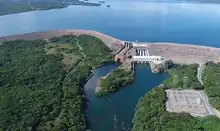| Manso Dam | |
|---|---|
 | |
 Location of Manso Dam in Brazil | |
| Official name | Represa de Manso |
| Country | Brazil |
| Location | Rosário Oeste, Mato Grosso, Brazil |
| Coordinates | 14°52′15″S 55°47′07″W / 14.870897°S 55.785176°W |
| Purpose | Hydroelectric power |
| Status | Operational |
| Construction began | 1988 |
| Opening date | 1999 |
| Dam and spillways | |
| Impounds | Manso River Roncador River Casca River |
| Height | 72 m (236 ft) |
| Length | 3,680 m (12,070 ft) |
| Spillway capacity | 2,990 m3/s (106,000 cu ft/s) |
| Reservoir | |
| Total capacity | 7,300,000,000 m3 (5,900,000 acre⋅ft) |
| Catchment area | 9,365 km2 (3,616 sq mi) |
| Surface area | 427 km2 (165 sq mi) |
| Usina Hidrelétrica de Manso | |
| Hydraulic head | 57.5 m (189 ft) (net) |
| Turbines | 4 x 53 MW Francis-type[1] |
| Installed capacity | 212 MW |
| Capacity factor | 43% |
The Manso Dam (Portuguese: Represa de Manso) is a hydroelectric dam on the Manso River, a tributary of the Cuiabá River, in the state of Mato Grosso, Brazil. Completed in 1999, it generates enough electricity for 300,000 people, and the reservoir is a tourist attraction. The dam displaced many families from the area now covered by the reservoir, and the submerged, decaying vegetation has had negative impact on water quality in and below the dam, affecting edible fish stocks.
Location
The dam impounds the Manso River in the upper Paraguay sub-basin of the Paraná basin. The reservoir is in the municipalities of Chapada dos Guimarães and Rosário Oeste in the midwest region of Mato Grosso.[2] It is the largest in the Paraopeba system.[3] The dam is 86 kilometres (53 mi) from Cuiabá, the state capital, along good roads. It is about 360 metres (1,180 ft) above sea level. The lake has become a tourist attraction.[4]
Structure
The dam project was launched in 1974, when a flood of the Cuiabá River left more than 20% of the population of the state capital homeless. The objective was to control flooding while generating electricity, developing tourism and supporting irrigation. Construction began in 1988 and was completed in 1999.[5] The dam has a height of 72 metres (236 ft).[6] 200,000 cubic metres (7,100,000 cu ft) of concrete were used in construction.[7] Total cost was R$340 million.[2] The reservoir covers an area of 427 square kilometres (165 sq mi).[6] It was full in 2001.[5]
The operating contract is 70% owned by Eletrobras Furnas.[2] Installed capacity is 212 MW, with guaranteed output of 92 MW.[6] It can meet the power demands of 300,000 people.[8] After an extended drought, in December 2015 the water level had fallen to 28.7% of capacity. However, record rainfall raised it to 76% by June 2016.[3] At 70% capacity the water line is 6.59 metres (21.6 ft) above the minimum operating level.[8]
Social and environmental impact
Relatively little information was provided about the dam to the affected people in Mato Grosso.[9] 109 properties were requisitioned for the project, and between 652 and 1,065 families were displaced.[6] The displaced families were settled in areas with sandy soil, unsuitable for agriculture, and given insanitary straw shacks as homes.[9]
The reservoir submerged a significant quantity of biomass, which was not cleared before construction started. This reduces dissolved oxygen levels as it decays and encourages proliferation of water weeds. Rather than use a surface-level channel to divert excess water downstream, the design uses a drain from the reservoir bottom, feeding the worst-quality water downstream. This has had a negative effect on edible fish stocks in the Cuiabá River.[9] By reducing flooding the dam affects the Mato Grosso Pantanal environment, which depends on seasonal floods, but does not fully protect Cuiabá from floods when the reservoir is full.[7]
Notes
- ↑ Manso Hydroelectric Plant.
- 1 2 3 Manso – OSA da Baragens, Financeiro.
- 1 2 Guilherme Paranaiba 2016.
- ↑ LAGO DE MANSO - Estrutura turistica ...
- 1 2 José Rodolpho Assenço 2013.
- 1 2 3 4 Manso – OSA da Baragens, Informações Técnicas.
- 1 2 Usina hidrelétrica ameaça futuro.
- 1 2 Renê Dióz 2014.
- 1 2 3 Manso – OSA da Baragens, Transformações.
Sources
- Guilherme Paranaiba (7 June 2016), "Represa do Rio Manso chega a volume alcançado pela última vez ha quase dois anos", em.com (in Portuguese), retrieved 2016-07-18
- José Rodolpho Assenço (9 July 2013), "O Lago do Manso", fotostrada (in Portuguese), retrieved 2016-07-18
- "LAGO DE MANSO - Estrutura turistica em expansão", Portal Turismo MT (in Portuguese), retrieved 2016-07-18
- "Manso", Observatório Sócio-Ambiental da Baragens (in Portuguese), retrieved 2016-07-18
- "Manso Hydroelectric Plant", FURNAS, retrieved 2016-07-28
- Renê Dióz (30 September 2014), Reservatório da principal hidrelétrica de MT está com 70% da capacidade (in Portuguese), retrieved 2016-07-18
- "Usina hidrelétrica ameaça futuro", Diario de Cuiabá (in Portuguese), retrieved 2016-07-18